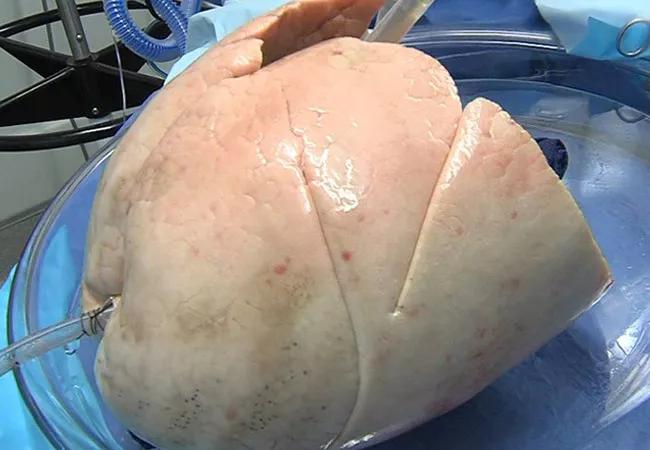Consensus statement aims to increase use of the perfusion technology and raise transplant volumes

Ex vivo lung perfusion (EVLP), which allows donor lungs to be evaluated and treated after organ donation but before transplantation, has increased the number of lung transplants in some centers by 20% or more. Introduced in 2001, the technology enables clinicians to verify donor lungs of uncertain quality and recondition lungs of borderline quality. However, it is not widely or consistently used, with few transplant centers having EVLP systems in-house.
Advertisement
Cleveland Clinic is a non-profit academic medical center. Advertising on our site helps support our mission. We do not endorse non-Cleveland Clinic products or services. Policy
“Much of the evidence for using EVLP has come from single-center studies, and EVLP protocols can vary from center to center,” says Kenneth McCurry, MD, Director of the Cleveland Clinic Enterprise Transplant Center. “As a result, there is little evidence-based guidance on which lungs should be put on EVLP and how to determine if they’re acceptable for transplant.”
In response, a group of 18 experts from the U.S. and Canada has authored the first consensus statement on using EVLP. In addition to helping standardize protocols, the authors hope that their recommendations published in the Journal of Thoracic Disease (2025 Apr 30;17(4):1832-1843) will help increase use of EVLP and, therefore, increase lung transplant volumes across the U.S.
“EVLP has many benefits for the lung transplant community, including expanding the donor lung pool, assessing lung quality before transplant, reducing waiting list mortality, improving patient outcomes, and offering a platform for therapeutic delivery and research,” says consensus coauthor Marie Budev, DO, MPH, Medical Director of Lung Transplantation at Cleveland Clinic. “Cleveland Clinic continues to lead the use of EVLP in lung transplantation.”
Cleveland Clinic, the largest EVLP center in the U.S., has used the technology on nearly 300 lungs since 2016.
“We do it for lungs that we think are marginal or may be unsuitable for direct transplant,” says Dr. McCurry, senior author of the consensus statement. “Evaluation and treatment through EVLP has increased Cleveland Clinic’s lung transplant volume by 30%-40%. Historically, we’ve averaged about 130 lung transplants per year — 30-40 of which come from EVLP. We’re on pace for 155 transplants in 2025, and we expect a similar proportion of those to be possible because of EVLP.”
Advertisement
EVLP can be performed on stationary devices either at a lung transplant hospital or a third-party facility, like those operated in the U.S. by Lung Bioengineering. Those stationary platforms — which pump a special perfusate through explanted lungs to maintain circulation and normal body temperature while lung function is assessed — typically use a bloodless solution. Also available is a portable EVLP platform that uses a blood-based solution.
The consensus statement focuses on stationary platforms using a bloodless solution, reflecting the experience of the authors.
Among the authors’ key recommendations is that donor lungs with unclear or marginal quality should be placed on EVLP.
“There are some exceptions,” Dr. McCurry notes. “If there’s a significant infection in the airway or significant pneumonia or a big lung infarction, then maybe EVLP is not appropriate. However, currently in the U.S., many lungs that are marginal are being discarded on a daily basis. We think there is more opportunity to use EVLP to more thoroughly evaluate those lungs and that many would end up being transplantable, saving more lives.”
The consensus statement lists the following factors or variables to be considered when determining whether or not to place lungs on EVLP:
Additional factors, such as edema on palpation and type of lung injury, also can be considered.
Lungs that meet standard criteria for transplant do not need to be placed on EVLP, nor do those deemed unsuitable for transplant due to infection or infarction.
Advertisement
When determining whether or not EVLP lungs are suitable for transplantation, the statement details criteria including:
EVLP lungs that are stable or improving on these criteria are suitable for transplant. Additional factors, such as pulmonary vascular resistance and weight gain, also can be considered if lung suitability is uncertain.
According to the published consensus, lungs that are deemed suitable for transplantation after EVLP are “equivalent to lungs that meet standard criteria initially.”
While these EVLP practices are already standard at Cleveland Clinic, they could be adopted by other centers, notes Dr. McCurry.
“Many lung transplant centers in the U.S. have little experience with EVLP,” he says. “Maybe they don’t have the resources to do it internally, but that’s where a third party can assist. Maybe they view the process as complex or daunting, but that’s where more experienced programs can offer support. Even if you’re a small program doing 10 to 20 lung transplants per year, there is a network that can help you start to increase transplant volume by using EVLP.”
The goal of EVLP is to make more lungs available, thereby saving more lives, he notes. Currently, four out of five donor lungs are declined for transplant in the U.S.
Advertisement
“We still have about 150-200 deaths per year of people waiting for lung transplant,” Dr. McCurry says. “With EVLP technology, we could potentially double the number of lung transplants in the U.S. over the next five or six years.”
For more on EVLP from Drs. McCurry and Budev, listen to the below episode of Cleveland Clinic's Cardiac Consult podcast for medical professionals.
Advertisement
Advertisement

Insights on bringing Cleveland Clinic even closer to becoming the best transplant enterprise in the world

Minimally invasive approach, peri- and postoperative protocols reduce risk and recovery time for these rare, magnanimous two-time donors

Minimally invasive pancreas-kidney replacement reduces patient’s pain, expedites recovery

Largest study to date confirms mortality rates similar to DBD transplant and reveals risk factors

Patient receives liver transplant and a new lease on life

More than 30% of patients die when early dialysis is needed after surgery

AHA recommendations for pretransplant evaluation, peritransplant and long-term management

Highlights and insights from recent Cleveland Clinic experience